The Grassland Farmer of the Year competition is part of the Grass 10 programme spearheaded by Teagasc with industry sponsors AIB, Grassland Agro, FBD, Department of Agriculture and the Irish Farmers Journal.
Competing farmers are shortlisted for a visit by the judges based on a desktop analysis of grass growth, number of grazings, nitrogen use, production and costs.
There are 10 finalists in this year’s competition. The judges are Bridget Lynch and John Maher from Teagasc, Liz Hyland from Department of Agriculture, Colin Heaney from FBD, Bryan Doocey from AIB, John O’Loughlin from Grassland Agro and Aidan Brennan from Irish Farmers Journal.
Farmers are judged on grassland management, sustainability, grazing infrastructure and health and safety.
Daniel Rundle – Ardee, Co Louth
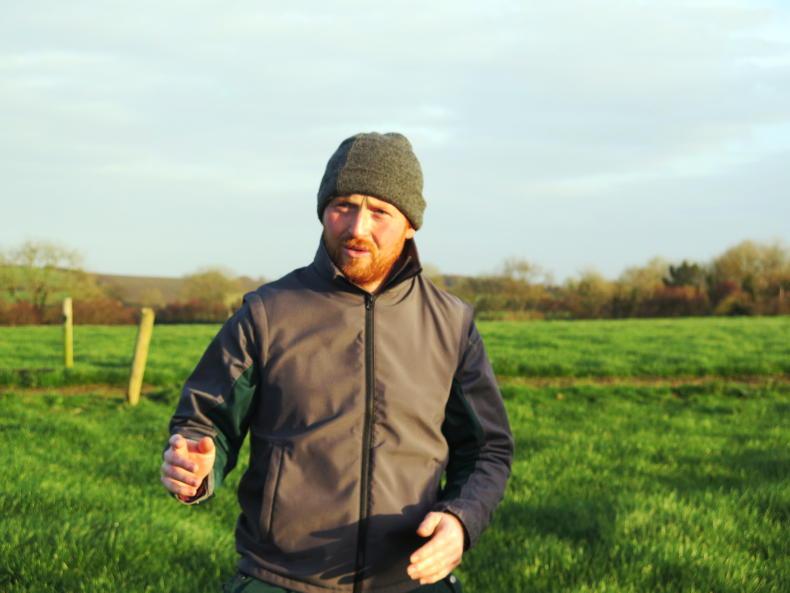
Daniel Rundle.
Farming with his uncle PJ near Ardee in Co Louth, Daniel Rundle is milking 120 cows on a challenging farm.
When the judges visited in mid-November, Daniel was just after drying off the last of the cows, giving a good long dry period before the start of calving in late January.
Despite the early dry-off date, milk production is very good, with 508kg MS/cow delivered to the creamery from 710kg of meal fed per cow this year.
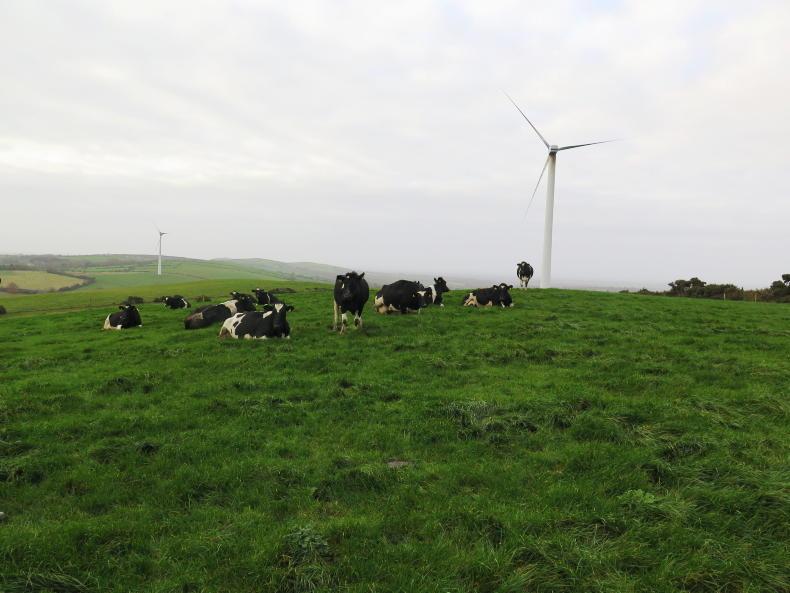
Daniel Rundle's farm.
Daniel’s aim is to feed no more than 500kg of meal per cow, something he achieves more often than not. The milking platform is stocked at 2.77 cows/ha. The challenging nature of the farm is due to the fact that about 40% of the milking platform is on the side of a steep hill. The lower land down at the yard is home to some of Daniel’s best land and some of his wettest land. The heifer-rearing block is contiguous to the milking platform but is rarely if ever used for grazing cows because the walks are just too long and there’s too much of a pull on the hill. The recently dried off cows were grazing this area when the judges visited, with wind turbines for company.
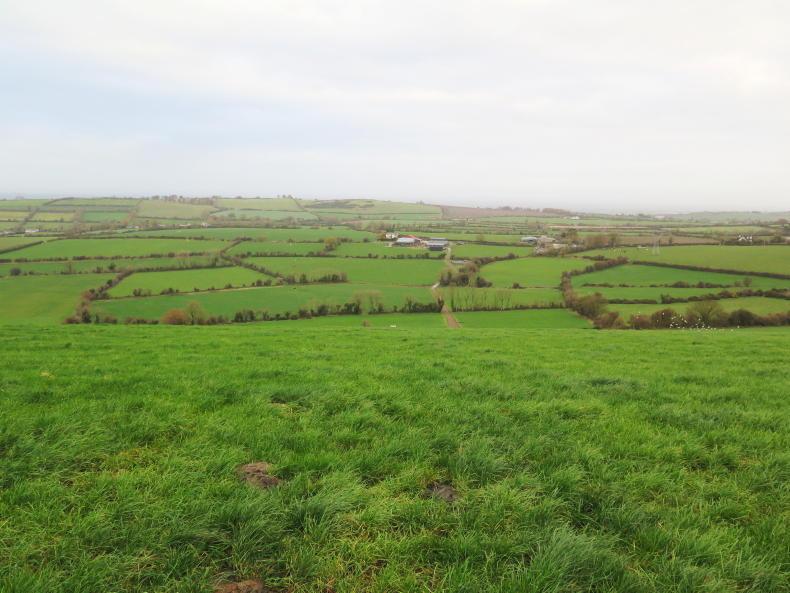
Daniel Rundle's farm.
Average grass growth for the last three years is 13.2tDM/ha, with 12.4tDM/ha recorded to mid-November in 2021. Daniel is good to walk the farm, having measured 40 times in 2021. He spread 230kg N/ha across the farm in 2021 and his long-term aim is to get this down to 180kg N/ha by incorporating more clover into the grazing swards. There is some clover in many paddocks but as yet not enough to replace chemical nitrogen.
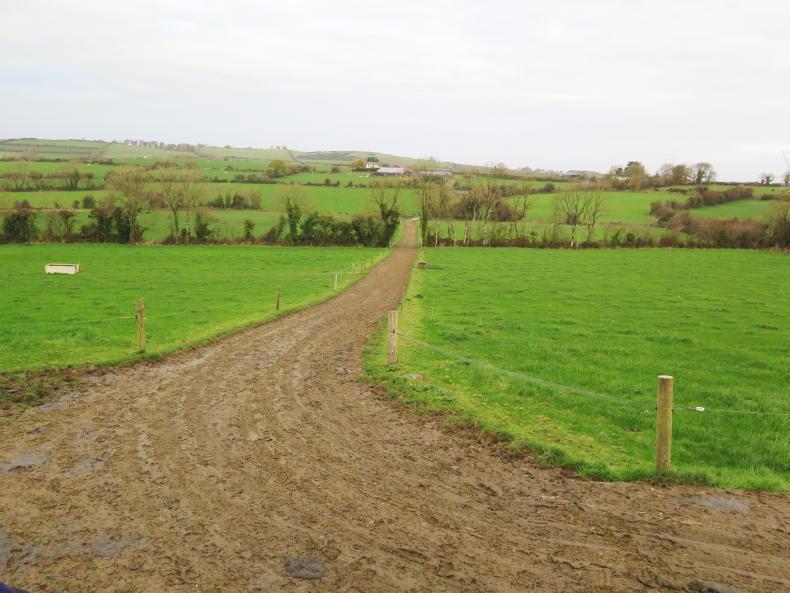
Daniel Rundle's farm.
The challenge with clover on this farm is the fact that the hill is low in soil fertility. It is index two for phosphorus and potassium, which will be an issue with getting clover established here. At this stage, 85% of the farm has been reseeded in recent years and Daniel plans to keep reseeding about 8% of the farm per year.
Philip Tyndall – Bunclody, Co Wexford
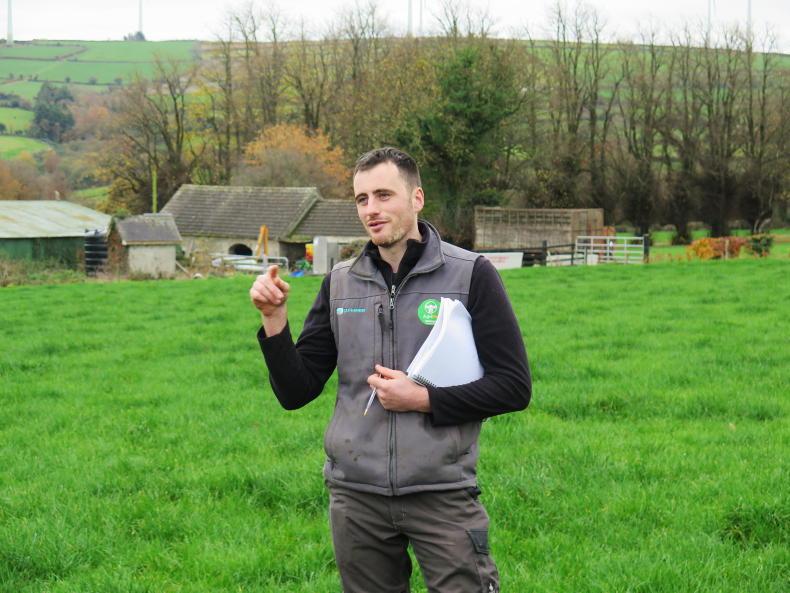
Philip Tyndall.
Farming alongside his father John, Philip Tyndall is milking 135 cows on a dry, free-draining farm outside Bunclody in Co Wexford.
The farm was purchased by Philip’s parents 17 years ago and since then they have put in huge work in getting the farm to where it is today.
The 37ha milking platform is highly stocked at 3.6 cows/ha but a 12ha support block is used for silage while heifers are contract-reared, returning in September to graze the outblock before being housed.
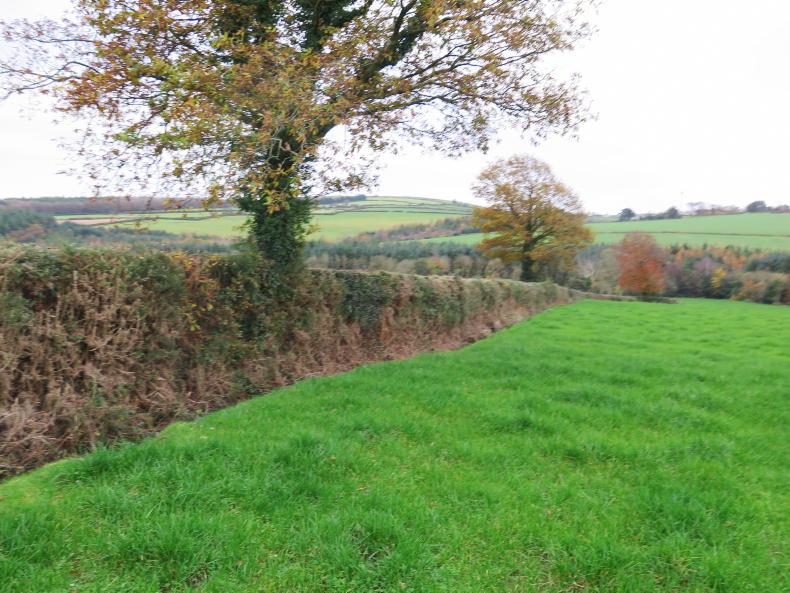
Philip Tyndall, Bunclody, Co Wexford, is a finalist in Grassland Farmer of the Year 2021.
Every field bar one has been reseeded in the last five years, with 13% reseeded this year along with 12% oversown with clover.
The Tyndalls have their own tine harrow and air seeder which they use for oversowing the clover.
Most of the fields have been reseeded with monoculture grass varieties and Philip is a big fan of tetraploids such as Abergain.
Average grass growth rate over the last three years is 14tDM/ha and 2021 looks like it will be similar to this.
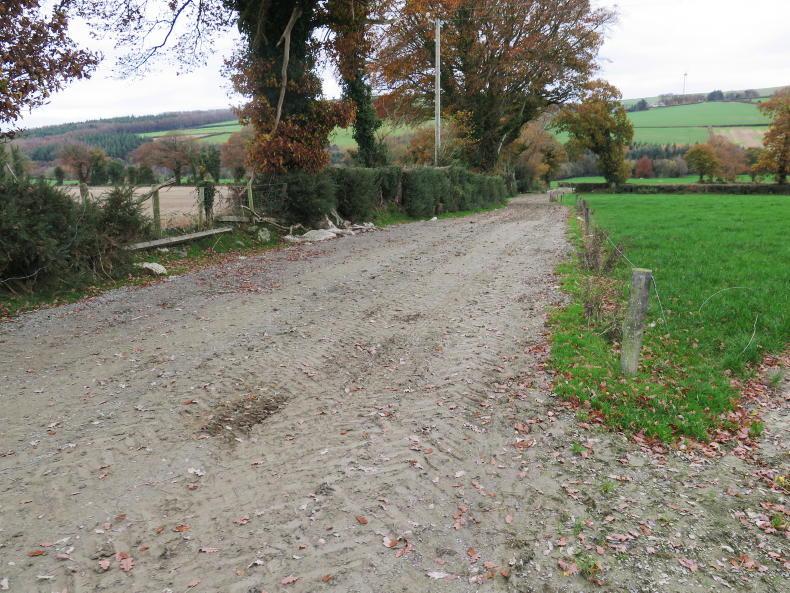
Philip Tyndall's farm.
The amount of chemical nitrogen being applied has reduced in recent years and Philip plans to reduce this further as clover is well established across many parts of the farm. This year, 248kg N/ha of chemical nitrogen was applied across the milking platform, with 213kg N/ha on the whole farm.
Looking to next year, Philip says he plans to spread slurry over a wider area as previously 3,000 gallons/acre was spread in early spring but this will be reduced to 2,000 gallons/acre and he also plans to cut back to half-rate nitrogen on the paddocks with a high clover content. The target is to spread 200kg N/ha on the milking platform.
The herd has a Jersey crossbred background but high-EBI black and white bulls have been used in recent years.
The EBI is €161 and they delivered 537kg MS/cow to Glanbia last year.
Meal feeding is at the higher end of the scale, with 1.2t of meal expected to be fed in 2021.
Philip aims to have a pre-grazing cover of 1,400kg to 1,500kg during the summer months.
Target cover per cow for the mid-season is 160kg to 170kg.
The farm is very picturesque, with lots of mature trees dotted around the hedgerows and 13 acres of native woods at the bottom of the farm alongside a stream.
Colin Doherty – Adare, Co Limerick
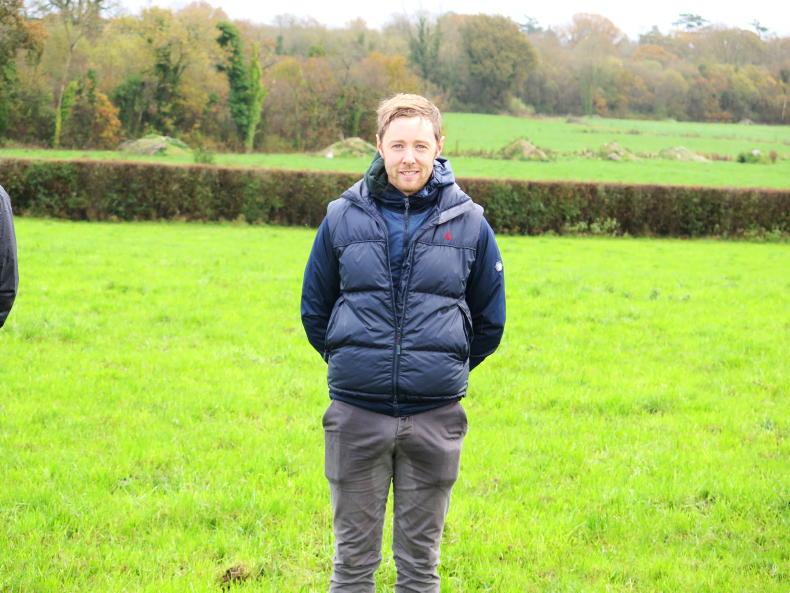
Colin Doherty, Adare, Co Limerick, is a finalist in Grassland Farmer of the Year competition 2021.
Colin Doherty is milking 200 cows outside the town of Adare in Co Limerick.
Farming with his father Bryan, the pair have grown cow numbers from 90 in 2015 and plan to milk 235 cows next year, which will be a stocking rate of three cows/ha.
With 109ha in the farm in total and with heifers contract-reared, the overall stocking rate will be 2.15 cows/ha.
Colin is big into grass and clover and will grow close to 15t DM/ha this year from around 210kg N/ha of chemical nitrogen.

Colin Doherty's farm.
Some red clover has been planted on the silage blocks on the outfarm which will reduce the farm’s overall reliance on chemical nitrogen.
Just over 30% of the milking platform has good clover content and this was evident even in late November this year.
The herd of Jersey crossbred cows are on track to deliver a little less than 430kg MS/cow this year from 520kg of meal fed per cow.

Colin Doherty's farm.
Colin says 50% of the herd are first- and second-lactation and their average liveweight is 480kg. His aim is to deliver 1kg of milk solids for every 1kg of liveweight and feed no more than 500kg of meal.
Clover was oversown last May by his contractor using an Erth seeder. Colin grazed this all summer at light covers to keep light on the clover seedlings and eased off of chemical nitrogen on these paddocks.
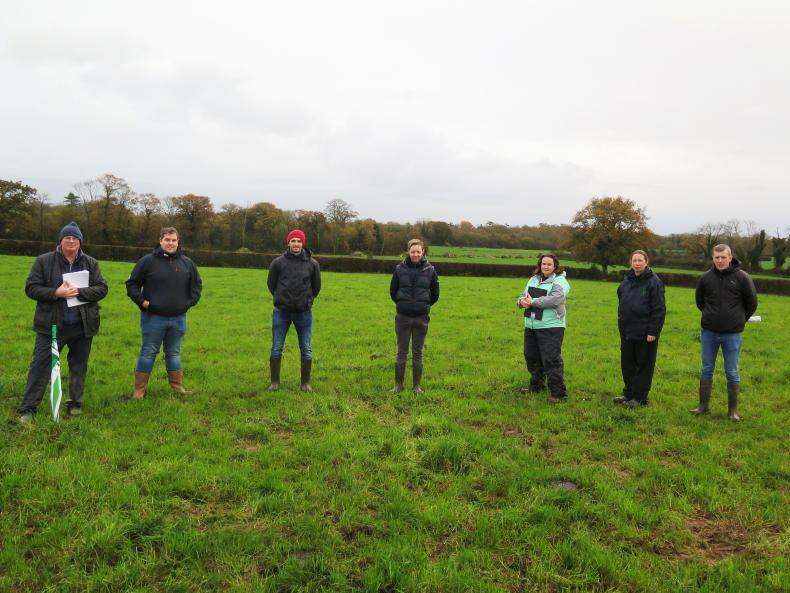
The judges on Colin Doherty's farm.
Colin uses the ‘days since last spread’ tool on PastureBase to determine when to spread fertiliser and while most paddocks are spread every 20 days or so, the high-clover paddocks are spread every 30 days.
He says that some of the fields where he is encouraging clover would be turning a bit yellow by day 30, but paddocks with plenty of clover would be performing very well. The clover swards got an average of 165kg N/ha this year.
Colin got his slurry tested last year and the results came back that for every 1,000 gallons of slurry there were 11 units of N, 2.5 units of P and just 11 units of K, which is lower than the book value for K. For this reason, he tops up silage fields with extra potash.
The farm is soil-sampled every two years and 100t of lime has been spread in the last two years.

Colin Doherty's farm.
During the main grazing season Colin will walk the farm twice a week and take action if covers have gone too strong or a deficit is coming. With typically no meal in the diet from April on, Colin says grassland management is more unforgiving as there is no safety net of meal. Therefore, he feels the pre-grazing yield of 1,300kg to 1,350kg/ha is critical for high intakes of quality grass and low residuals leading to quality in the next round.
The Grassland Farmer of the Year competition is part of the Grass 10 programme spearheaded by Teagasc with industry sponsors AIB, Grassland Agro, FBD, Department of Agriculture and the Irish Farmers Journal.
Competing farmers are shortlisted for a visit by the judges based on a desktop analysis of grass growth, number of grazings, nitrogen use, production and costs.
There are 10 finalists in this year’s competition. The judges are Bridget Lynch and John Maher from Teagasc, Liz Hyland from Department of Agriculture, Colin Heaney from FBD, Bryan Doocey from AIB, John O’Loughlin from Grassland Agro and Aidan Brennan from Irish Farmers Journal.
Farmers are judged on grassland management, sustainability, grazing infrastructure and health and safety.
Daniel Rundle – Ardee, Co Louth

Daniel Rundle.
Farming with his uncle PJ near Ardee in Co Louth, Daniel Rundle is milking 120 cows on a challenging farm.
When the judges visited in mid-November, Daniel was just after drying off the last of the cows, giving a good long dry period before the start of calving in late January.
Despite the early dry-off date, milk production is very good, with 508kg MS/cow delivered to the creamery from 710kg of meal fed per cow this year.

Daniel Rundle's farm.
Daniel’s aim is to feed no more than 500kg of meal per cow, something he achieves more often than not. The milking platform is stocked at 2.77 cows/ha. The challenging nature of the farm is due to the fact that about 40% of the milking platform is on the side of a steep hill. The lower land down at the yard is home to some of Daniel’s best land and some of his wettest land. The heifer-rearing block is contiguous to the milking platform but is rarely if ever used for grazing cows because the walks are just too long and there’s too much of a pull on the hill. The recently dried off cows were grazing this area when the judges visited, with wind turbines for company.

Daniel Rundle's farm.
Average grass growth for the last three years is 13.2tDM/ha, with 12.4tDM/ha recorded to mid-November in 2021. Daniel is good to walk the farm, having measured 40 times in 2021. He spread 230kg N/ha across the farm in 2021 and his long-term aim is to get this down to 180kg N/ha by incorporating more clover into the grazing swards. There is some clover in many paddocks but as yet not enough to replace chemical nitrogen.

Daniel Rundle's farm.
The challenge with clover on this farm is the fact that the hill is low in soil fertility. It is index two for phosphorus and potassium, which will be an issue with getting clover established here. At this stage, 85% of the farm has been reseeded in recent years and Daniel plans to keep reseeding about 8% of the farm per year.
Philip Tyndall – Bunclody, Co Wexford

Philip Tyndall.
Farming alongside his father John, Philip Tyndall is milking 135 cows on a dry, free-draining farm outside Bunclody in Co Wexford.
The farm was purchased by Philip’s parents 17 years ago and since then they have put in huge work in getting the farm to where it is today.
The 37ha milking platform is highly stocked at 3.6 cows/ha but a 12ha support block is used for silage while heifers are contract-reared, returning in September to graze the outblock before being housed.

Philip Tyndall, Bunclody, Co Wexford, is a finalist in Grassland Farmer of the Year 2021.
Every field bar one has been reseeded in the last five years, with 13% reseeded this year along with 12% oversown with clover.
The Tyndalls have their own tine harrow and air seeder which they use for oversowing the clover.
Most of the fields have been reseeded with monoculture grass varieties and Philip is a big fan of tetraploids such as Abergain.
Average grass growth rate over the last three years is 14tDM/ha and 2021 looks like it will be similar to this.

Philip Tyndall's farm.
The amount of chemical nitrogen being applied has reduced in recent years and Philip plans to reduce this further as clover is well established across many parts of the farm. This year, 248kg N/ha of chemical nitrogen was applied across the milking platform, with 213kg N/ha on the whole farm.
Looking to next year, Philip says he plans to spread slurry over a wider area as previously 3,000 gallons/acre was spread in early spring but this will be reduced to 2,000 gallons/acre and he also plans to cut back to half-rate nitrogen on the paddocks with a high clover content. The target is to spread 200kg N/ha on the milking platform.
The herd has a Jersey crossbred background but high-EBI black and white bulls have been used in recent years.
The EBI is €161 and they delivered 537kg MS/cow to Glanbia last year.
Meal feeding is at the higher end of the scale, with 1.2t of meal expected to be fed in 2021.
Philip aims to have a pre-grazing cover of 1,400kg to 1,500kg during the summer months.
Target cover per cow for the mid-season is 160kg to 170kg.
The farm is very picturesque, with lots of mature trees dotted around the hedgerows and 13 acres of native woods at the bottom of the farm alongside a stream.
Colin Doherty – Adare, Co Limerick

Colin Doherty, Adare, Co Limerick, is a finalist in Grassland Farmer of the Year competition 2021.
Colin Doherty is milking 200 cows outside the town of Adare in Co Limerick.
Farming with his father Bryan, the pair have grown cow numbers from 90 in 2015 and plan to milk 235 cows next year, which will be a stocking rate of three cows/ha.
With 109ha in the farm in total and with heifers contract-reared, the overall stocking rate will be 2.15 cows/ha.
Colin is big into grass and clover and will grow close to 15t DM/ha this year from around 210kg N/ha of chemical nitrogen.

Colin Doherty's farm.
Some red clover has been planted on the silage blocks on the outfarm which will reduce the farm’s overall reliance on chemical nitrogen.
Just over 30% of the milking platform has good clover content and this was evident even in late November this year.
The herd of Jersey crossbred cows are on track to deliver a little less than 430kg MS/cow this year from 520kg of meal fed per cow.

Colin Doherty's farm.
Colin says 50% of the herd are first- and second-lactation and their average liveweight is 480kg. His aim is to deliver 1kg of milk solids for every 1kg of liveweight and feed no more than 500kg of meal.
Clover was oversown last May by his contractor using an Erth seeder. Colin grazed this all summer at light covers to keep light on the clover seedlings and eased off of chemical nitrogen on these paddocks.

The judges on Colin Doherty's farm.
Colin uses the ‘days since last spread’ tool on PastureBase to determine when to spread fertiliser and while most paddocks are spread every 20 days or so, the high-clover paddocks are spread every 30 days.
He says that some of the fields where he is encouraging clover would be turning a bit yellow by day 30, but paddocks with plenty of clover would be performing very well. The clover swards got an average of 165kg N/ha this year.
Colin got his slurry tested last year and the results came back that for every 1,000 gallons of slurry there were 11 units of N, 2.5 units of P and just 11 units of K, which is lower than the book value for K. For this reason, he tops up silage fields with extra potash.
The farm is soil-sampled every two years and 100t of lime has been spread in the last two years.

Colin Doherty's farm.
During the main grazing season Colin will walk the farm twice a week and take action if covers have gone too strong or a deficit is coming. With typically no meal in the diet from April on, Colin says grassland management is more unforgiving as there is no safety net of meal. Therefore, he feels the pre-grazing yield of 1,300kg to 1,350kg/ha is critical for high intakes of quality grass and low residuals leading to quality in the next round.
















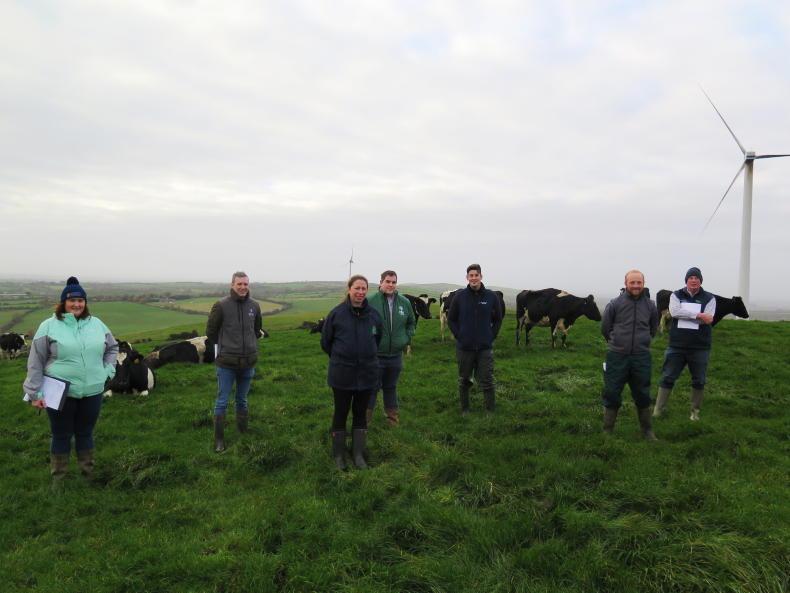
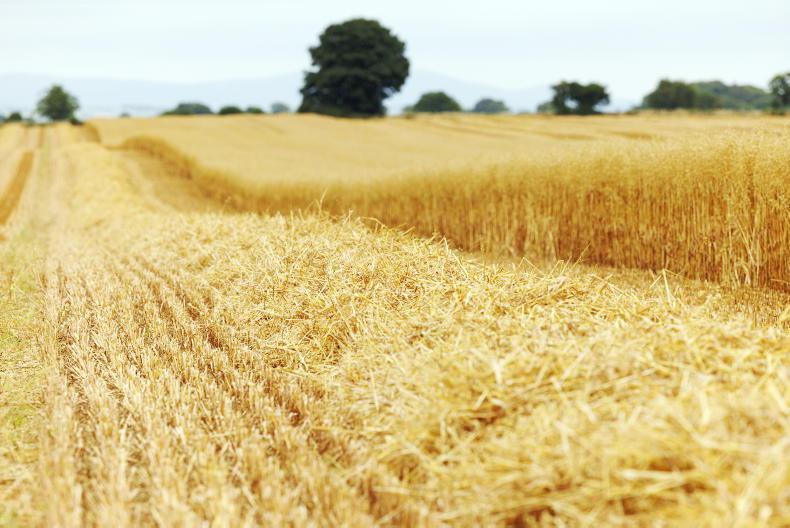

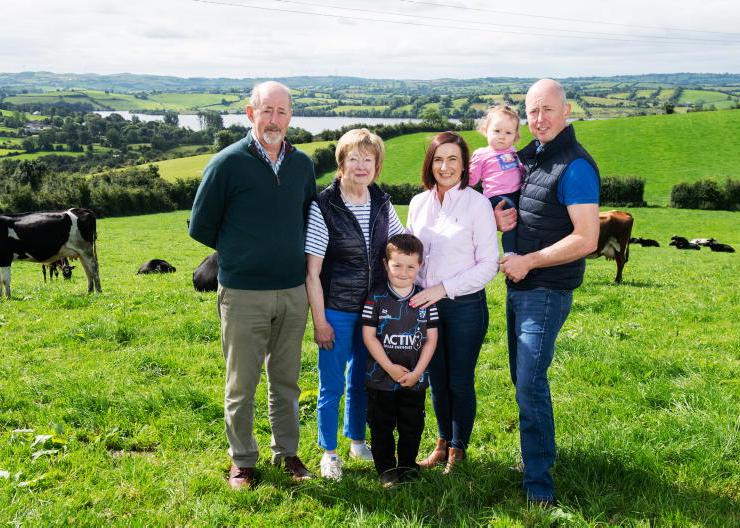
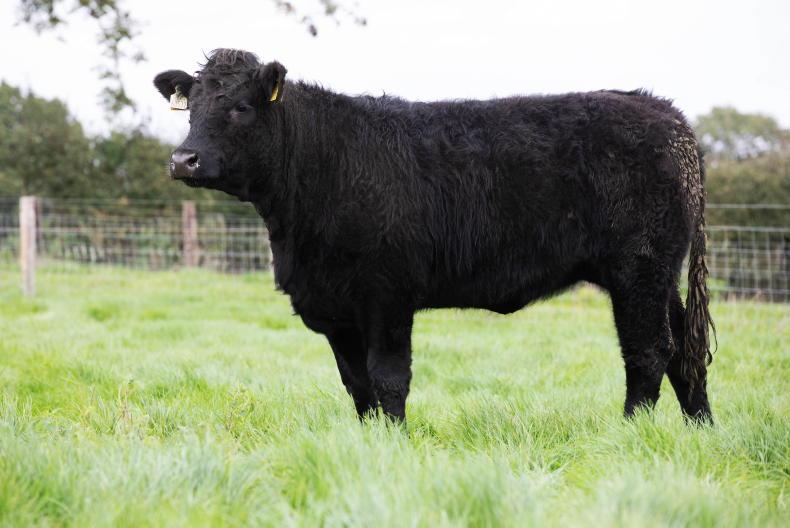
SHARING OPTIONS